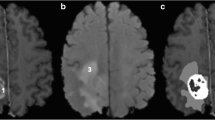Abstract
The volume of a brain lesion (e.g. infarct or tumor) is a powerful indicator of patient prognosis and can be used to guide the therapeutic strategy. Lesional volume estimation is usually performed by segmentation with deep convolutional neural networks (CNN), currently the state-of-the-art approach. However, to date, few work has been done to equip volume segmentation tools with adequate quantitative predictive intervals, which can hinder their usefulness and acceptation in clinical practice. In this work, we propose TriadNet, a segmentation approach relying on a multi-head CNN architecture, which provides both the lesion volumes and the associated predictive intervals simultaneously, in less than a second. We demonstrate its superiority over other solutions on BraTS 2021, a large-scale MRI glioblastoma image database. Our implementation of TriadNet is available at https://github.com/benolmbrt/TriadNet.
Access this chapter
Tax calculation will be finalised at checkout
Purchases are for personal use only
Similar content being viewed by others
References
Angelopoulos, A.N., Bates, S.: A gentle introduction to conformal prediction and distribution-free uncertainty quantification. arXiv preprint arXiv:2107.07511 (2021)
Baid, U., Ghodasara, S., et al.: The RSNA-ASNR-MICCAI BraTS 2021 benchmark on brain tumor segmentation and radiogenomic classification. arXiv preprint arXiv:2107.02314 (2021)
Baris, M.M., Celik, A.O., et al.: Role of mass effect, tumor volume and peritumoral edema volume in the differential diagnosis of primary brain tumor and metastasis. Clin. Neurol. Neurosurg. 148, 67–71 (2016)
Cardoso, M.J., et al.: MONAI: an open-source framework for deep learning in healthcare. arXiv preprint arXiv:2211.02701 (2022)
Contador, J., Pérez-Millán, A., et al.: Longitudinal brain atrophy and CSF biomarkers in early-onset Alzheimer’s disease. NeuroImage Clin. 32, 102804 (2021)
Eaton-Rosen, Z., Varsavsky, T., Ourselin, S., Cardoso, M.J.: As easy as 1, 2...4? Uncertainty in counting tasks for medical imaging. In: Shen, D., et al. (eds.) MICCAI 2019. LNCS, vol. 11767, pp. 356–364. Springer, Cham (2019). https://doi.org/10.1007/978-3-030-32251-9_39
Gal, Y., Ghahramani, Z.: Dropout as a Bayesian approximation: representing model uncertainty in deep learning. In: International Conference on Machine Learning, vol. 48, pp. 1050–1059 (2016)
Ghoneem, A., Osborne, M.T., et al.: Association of socioeconomic status and infarct volume with functional outcome in patients with ischemic stroke. JAMA Netw. Open 5(4), e229178–e229178 (2022)
Guo, C., Pleiss, G., Sun, Y., Weinberger, K.Q.: On calibration of modern neural networks. In: International Conference on Machine Learning, pp. 1321–1330. PMLR (2017)
Hesamian, M.H., Jia, W., et al.: Deep learning techniques for medical image segmentation: achievements and challenges. J. Digit. Imaging 32, 582–596 (2019)
Kingma, D.P., Ba, J.: Adam: a method for stochastic optimization. In: 3rd International Conference on Learning Representations, ICLR 2015 (2015)
Kivaranovic, D., Johnson, K.D., Leeb, H.: Adaptive, distribution-free prediction intervals for deep networks. In: International Conference on Artificial Intelligence and Statistics, pp. 4346–4356 (2020)
Lakshminarayanan, B., Pritzel, A., Blundell, C.: Simple and scalable predictive uncertainty estimation using deep ensembles. Adv. Neural. Inf. Process. Syst. 30, 6402–6413 (2017)
Mattiesing, R.M., Gentile, G., et al.: The spatio-temporal relationship between white matter lesion volume changes and brain atrophy in clinically isolated syndrome and early multiple sclerosis. NeuroImage Clin. 36, 103220 (2022)
Milletari, F., Navab, N., Ahmadi, S.A.: V-Net: fully convolutional neural networks for volumetric medical image segmentation. In: 2016 Fourth International Conference on 3D Vision (3DV), pp. 565–571 (2016)
Oktay, O., Schlemper, J., et al.: Attention U-Net: learning where to look for the pancreas. In: Medical Imaging with Deep Learning (MIDL) (2018)
Pearce, T., Brintrup, A., et al.: High-quality prediction intervals for deep learning: a distribution-free, ensembled approach. In: International Conference on Machine Learning, pp. 4075–4084 (2018)
Pérez-García, F., Sparks, R., Ourselin, S.: Torchio: a python library for efficient loading, preprocessing, augmentation and patch-based sampling of medical images in deep learning. Comput. Methods Programs Biomed. 208, 106236 (2021)
Roca, P., Attye, A., et al.: Artificial intelligence to predict clinical disability in patients with multiple sclerosis using flair MRI. Diagn. Interv. Imaging 101(12), 795–802 (2020)
Salehi, S.S.M., Erdogmus, D., Gholipour, A.: Tversky loss function for image segmentation using 3D fully convolutional deep networks. In: Wang, Q., Shi, Y., Suk, H.-I., Suzuki, K. (eds.) MLMI 2017. LNCS, vol. 10541, pp. 379–387. Springer, Cham (2017). https://doi.org/10.1007/978-3-319-67389-9_44
Srivastava, N., Hinton, G., et al.: Dropout: a simple way to prevent neural networks from overfitting. J. Mach. Learn. Res. 15(1), 1929–1958 (2014)
Tagasovska, N., Lopez-Paz, D.: Single-model uncertainties for deep learning. In: Advances in Neural Information Processing Systems, vol. 32 (2019)
Wang, G., Li, W., Aertsen, M., Deprest, J., Ourselin, S., Vercauteren, T.: Aleatoric uncertainty estimation with test-time augmentation for medical image segmentation with convolutional neural networks. Neurocomputing 338, 34–45 (2019)
Author information
Authors and Affiliations
Corresponding author
Editor information
Editors and Affiliations
Rights and permissions
Copyright information
© 2023 The Author(s), under exclusive license to Springer Nature Switzerland AG
About this paper
Cite this paper
Lambert, B., Forbes, F., Doyle, S., Dojat, M. (2023). TriadNet: Sampling-Free Predictive Intervals for Lesional Volume in 3D Brain MR Images. In: Sudre, C.H., Baumgartner, C.F., Dalca, A., Mehta, R., Qin, C., Wells, W.M. (eds) Uncertainty for Safe Utilization of Machine Learning in Medical Imaging. UNSURE 2023. Lecture Notes in Computer Science, vol 14291. Springer, Cham. https://doi.org/10.1007/978-3-031-44336-7_4
Download citation
DOI: https://doi.org/10.1007/978-3-031-44336-7_4
Published:
Publisher Name: Springer, Cham
Print ISBN: 978-3-031-44335-0
Online ISBN: 978-3-031-44336-7
eBook Packages: Computer ScienceComputer Science (R0)





